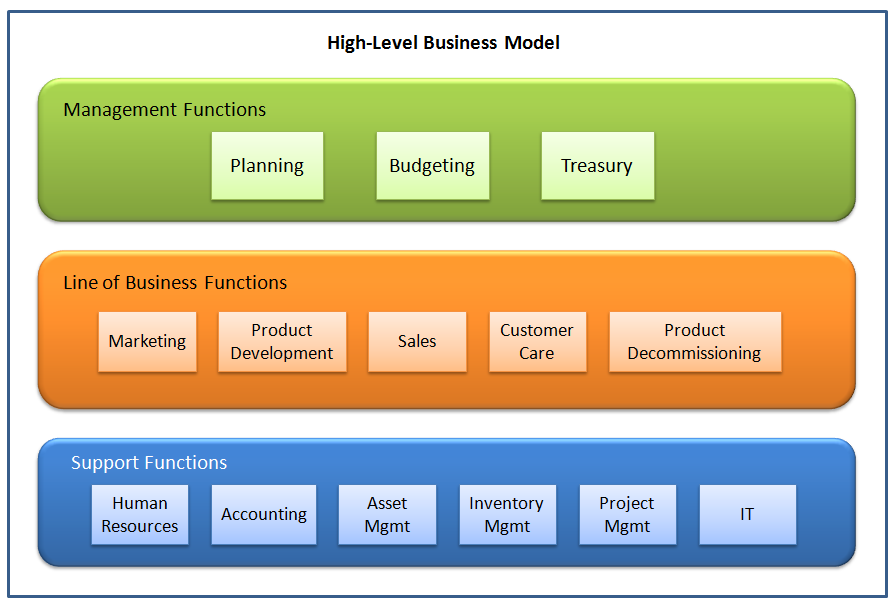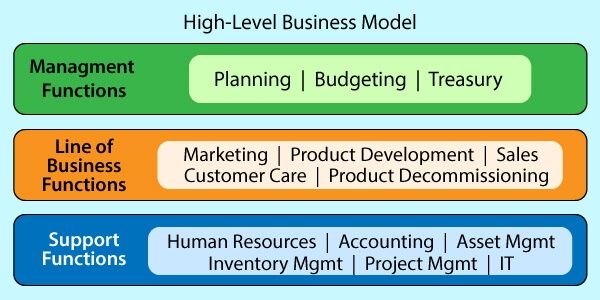This series is about well-defined data within the context of IT-based business information systems. In this article and the next, entities specific to an organization’s line(s) of business are discussed.
These entities represent an organization’s products, customers, sales, and sales-related locations. They will be viewed within the context of five line-of-business functions. These functions, taken in sequence, represent the business processes that support any product as it goes through its lifecycle.
For the purpose of the discussion of line-of-business-specific entities, the terms product, customer, sale, and location are defined as follows:
Product — This term is intended to represent either goods or services offered by an organization to its customers. Goods are things the customer can take ownership of, subject to available inventory. Services are resources (types of or specific persons or things) used by the customer for a period of time, subject to availability at a given point in time.
Customer — This term is used to represent an individual, group, or organization that consumes the organization’s products. Common industry-specific synonyms for the term include account holder, passenger, patient, and resident.
Sale — This term is used to represent any type of event where a customer commits to consuming one or more of the organization’s products. A sale can be immediate, such as a grocery purchase. The consuming related to a sale of a long-running product is ongoing, such as water or electricity usage. A sale can be a commitment to consume a product in the future, such as a ticket for a scheduled airline flight or concert.
Location — Within the context of line-of-business entities, a location is a place managed by the organization for the purpose of selling or the consuming of its products. Examples include, retail stores, hotels, library branches, and properties provisioned for access to utility services such as water or electricity.
Lines of Business
A line of business centres on the products an organization offers for sale to customers. Unlike generic business entities such as Staff Member or General Ledger Account, which have entity names, attributes, and relationships common across all organizations, the entity names, attributes, and relationships for entities representing the line-of-business concepts product, customer, sale, and location differ widely from business to business.
For example, in the commercial airline line-of-business, the entity representing the concept customer is referred to as a Passenger. The sales process can start with a Reservation for space within a specified seating class on a scheduled Flight. The good news is that while line-of-business-specific entities vary widely in this way, they tend to be similar among organizations in a given line of business.
Every organization will have at least one product, and therefore one line of business. An example of an organization that has multiple lines of business is the Walt Disney Company. Its products include films, film-related merchandise, and its Disney-themed amusement parks, hotel accommodations, and cruises.
Line-of-Business Functions
Entities representing customers, products, sales, and locations differ between different lines of business. However, there are five business functions that, taken in sequence, represent the business processes that support any product as it goes through its lifecycle. These functions are Marketing, Product Development, Sales, Customer Care, and Product Decommissioning.
 Figure 1 — Line of Business Functions Supporting a Product Through Its Lifecycle
Figure 1 — Line of Business Functions Supporting a Product Through Its Lifecycle
While at the highest level the line-of-business functions are common for any product, the business processes within each function will vary due to the differences in the types of products, customers, sales, and locations involved — for example, booking films with movie theatre operators involves very different processes than renting hotel accommodations to travellers. But while processes within each of these functions will differ based on the specific line of business, the overall objective of each function is common for any type of product.
Marketing — The objective of marketing is to identify and maintain products that strike a balance between the organization’s goals and objectives, and the affordable needs or wants of customers (or potential customers). Product-related decisions include what new products should be offered, what changes, if any, should be made to existing products, and when to cease offering a product. These decisions may be supported by a business case that presents projected revenues, costs, and risks for one or more options.
When the organization decides to move ahead with an option, the product development phase of the product’s lifecycle begins.
Product Development — The objective of the product development function is to ‘bring the product to market’. Having decided to add, change, or decommission a product, things need to happen within the organization. The decision may be as simple as changing the price of an existing product, or as complex as adding a whole new line of business. Existing business processes may require changing, or whole new processes needed to be put into place.
If new or existing business processes are to be supported by an IT-based system, that system needs to be put in place, modified, or data within it updated (e.g. pricing changes). If an existing IT system is being replaced by a new one, migration of data may need to be carried out. Where staff are affected by changes to processes and/or an IT system, training needs to be conducted for those affected.
Only after all the necessary additions or changes have been successfully ‘put into production’ is the organization ready for the sales phase for the product.
Sales — The objective of the sales function is to get customers through the product’s sales process (ideally along the process’s happy path). Where a process involves an IT-based system, the product development phase has done (and tested) what’s required to support the process. The products and locations have been set up in the system and are ready to be referenced during the sales process. The process may include adding a new customer. It will certainly involve recording details relevant to the sale. For long-running products, there will be processes for recording consumption over time.
NOTE: Where customers are encouraged or allowed to self-serve, they must be able to gain access to the appropriate user interfaces. Given access, well-defined data includes their being able to understand what information they need to provide to successfully carry out a given self-service process, such as purchasing products, or maintaining account details.
When a customer has a problem or issue after a sale, or during the operation of a long-running product, the processes within the product’s customer care lifecycle phase come into play.
Customer Care — The objective of the customer care function is to deal with customers in situations where something has gone wrong, or appears to have gone wrong, with the product they have been sold. For example, it’s broken, or is believed to be broken. Or the normal operation of a customer’s long-running product is not operating correctly, or appears to be not operating correctly. Or a customer wants to return the product, or cease consuming a long-running product.
To resolve these types of customer-related issues, customer care staff need access to line-of-business-specific details about the organization’s products, customers, sales, and locations. Ideally these have been recorded in an IT system during product development, sales, and customer care phases of the product lifecycle. Where customers are provided with self-serve support options, such as frequently asked questions) those product-specific details should be accessible.
Product Decommissioning — The objective of the product decommissioning function is to end access to an existing product within the sales process. From an IT-based system perspective, it’s about preventing new instances of the sale event from occurring. For long-running products, where possible, existing customers would be switched to an alternate product that has been added as a successor product, or some other similar, available product.
Additional business processes within this function would include such things as notifying sales staff of the product being decommissioned, removing it from any advertising campaigns, and (at a designated point) curtailing customer care for it.
Having looked at the objectives of line-of-business functions that support any type of product going through its lifecycle, the next article will take a closer look at the four concepts representing line-of-business-specific entities.
Click here for Part 4 — Product, Customer, Sale, and Location Entities
Views: 392

 Figure 1 — Line of Business Functions Supporting a Product Through Its Lifecycle
Figure 1 — Line of Business Functions Supporting a Product Through Its Lifecycle
Fysio Dinxperlo
… [Trackback]
[…] Information to that Topic: batimes.com/articles/well-defined-data-part-3-line-of-business-specific-entities/ […]